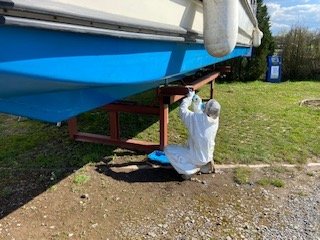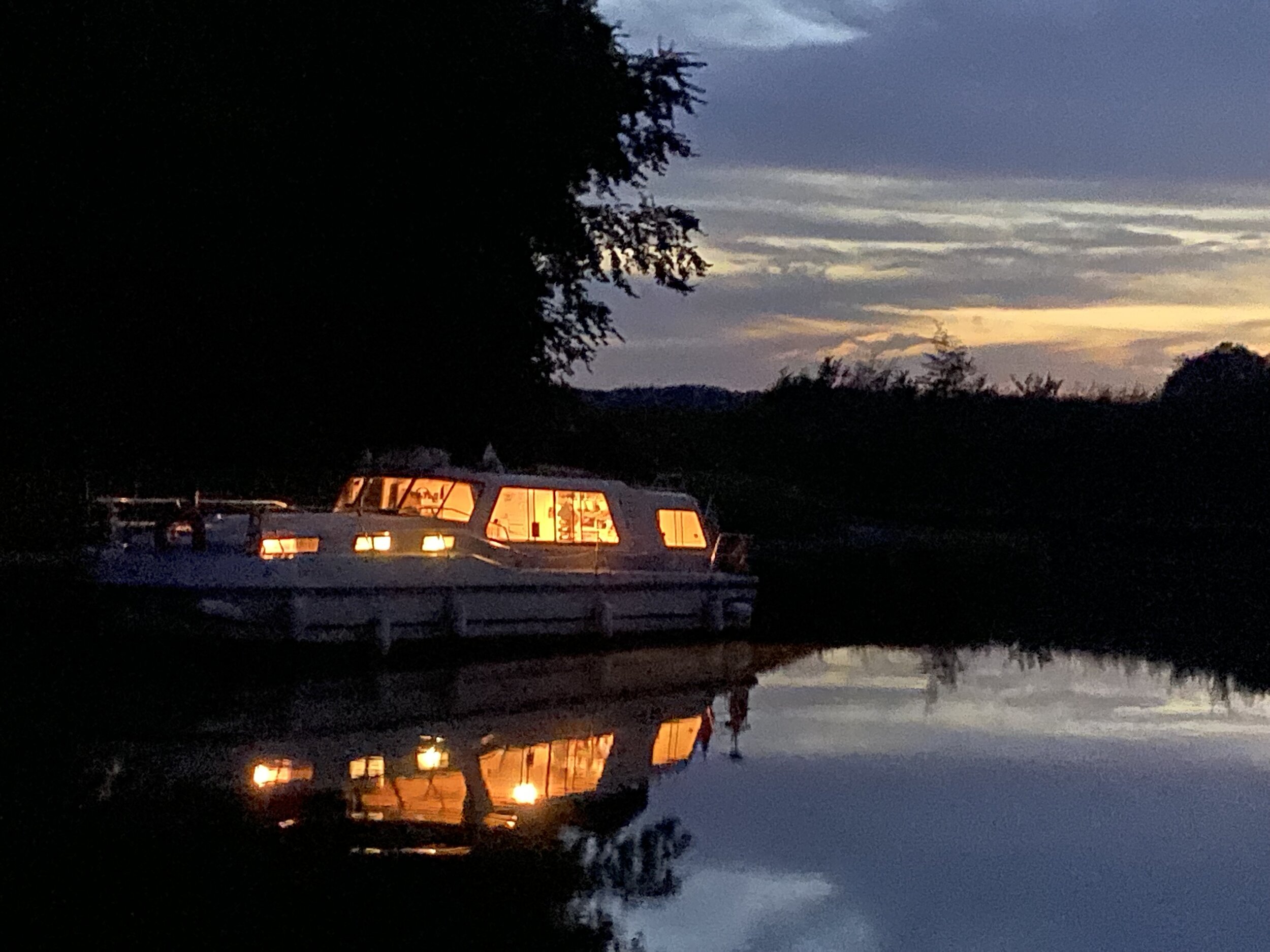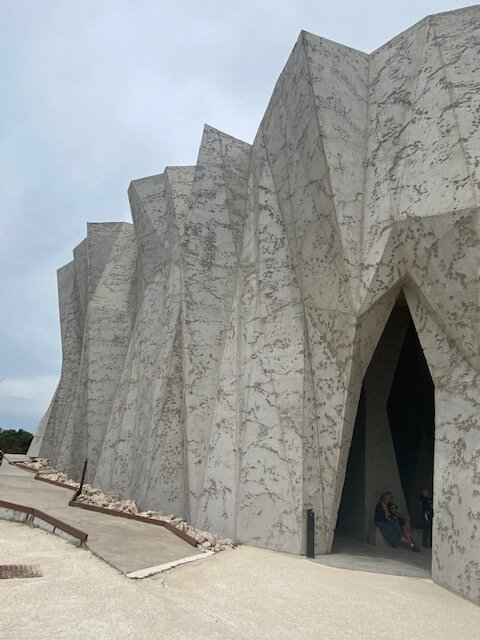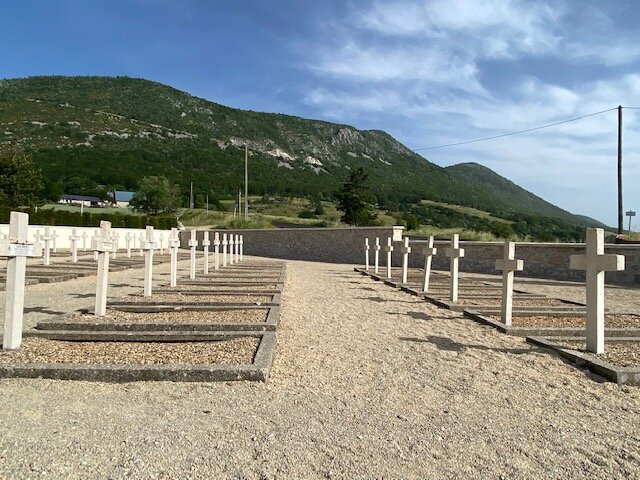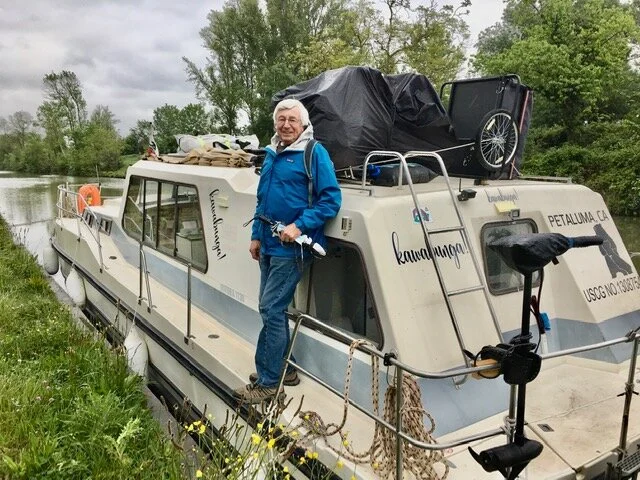Back in the Saddle / Remise en selle
/Grocery shopping day in Strasbourg
ENGLISH
Strasbourg May 7
We arrived back in Niderviller, France, (in the Lorraine region bordering Alsace), on April 6, where we had left Kawabunga drydocked for the winter. After about 10 days of negotiating some rain (and even one snowy morning!) we whittled down the “to-do” list (bottom painting the boat, a few “home” improvements here and there, major grocery shopping) and Kawabunga was back in the water in quick order.
But before fully reintegrating our boat life, we took advantage of our rental car and proximity to Germany for a little side road trip to Birkenfeld, where Michel was born, and to Saarburg where he also lived as young boy. After returning to Kawabunga, we decided to make our first fluvial foray up the Canal de la Sarre (Saar) back to the same area in Germany—a test run for what we hoped would be more German canal experiences. The first section of the Saar was rather industrial and uninviting but quickly gave way to the more pleasant and famous serene Saar Loop, Mettlach, and picturesque Saarburg (another perspective from the waterway versus our previous land access). Nevertheless, we were soured upon any further German canal journeys. Small private boats weren’t necessarily welcomed and infrastructure for such small boats was lacking. We also found local hospitality rather sketchy.
Heading back south, then east, to Strasbourg, we took advantage of some delightful anchorages once back in France, one of which was near the wild animal park Parc Animalier Sainte Croix, where we spent a day amongst wolves, bears, lynx, prairie dogs, and a host of deer species (elk, etc.) from all parts of the world.
Back on the Canal de la Marne au Rhin, we arrived in Strasbourg on May 7, our final end point in the east. From here I’ll be embarking on a two-week backpack trip through the Cevennes region on the Stevenson Trail, beginning May 15.
This area of France is all unfamiliar territory to both of us and the historical impact of the Franco-Germanic cultural mixes and influences due to the back-and-forth border fights and tug-of-wars over the Alsace region for centuries are pervasive. The majority of town names are unpronounceable, including the little port of Souffelweyersheim(!!) where we are currently moored.
Strasbourg has been a delight to discover: a beautiful, noble, and international city and the seat of the European Parliament. Street life is peppered with multi-lingual vibrance, and it seems there is a local Alsatian dialect which sounds like a mix of German and Dutch with French words peppered in here and there. The streets are a mosaic of automobile license plates varying from France, Germany, Romania, Poland, Bulgaria, Luxembourg, and more.
I’ll be returning to the boat on May 30 and then we’ll make headway west to Nancy.
Of Note:
• On the Saar River in Germany, the unique UNESCO preserved site of the historical Völklingen Iron Works factory: thoroughly fascinating and worth the visit!
• Some tongue twisting local names to try on for size!: Xouaxange, Schneckenbusch, Lutzelbourg, Dittwiller, Schwindratzheim, Waltenheim, Souffelweyersheim(!!)
• Our surprise as we rounded a curve in the canal to come upon a hulking blockhouse war relic designating the Ligne Maginot, as it discreetly reigned over the sunny peaceful grassy shore.
* Strasbourg and surrounding towns are VERY bicycle friendly: bicycle paths, accommodations, and many riders everywhere.
FRANÇAIS
Remise en selle
Strasbourg le 7 mai
Nous sommes arrivés le 6 avril à Niderviller, en France, (dans la région de la Lorraine qui borde l'Alsace), où nous avions laissé Kawabunga en cale sèche pour l'hiver. Après une dizaine de jours de négociations avec un peu de pluie (et même une matinée de neige !), nous avons complété la liste des choses à faire (carénage, petites améliorations ici et là, avitaillement) et Kawabunga a été remis à l'eau en un rien de temps.
Mais avant de réintégrer complètement notre vie de bateau, nous avons profité de notre voiture de location et de la proximité de l'Allemagne pour faire un petit tour à Birkenfeld, où Michel est né, et à Saarburg, où il a également vécu dans sa jeunesse. De retour sur Kawabunga, nous avons décidé de faire notre première incursion fluviale sur le canal de la Sarre pour retourner dans la même région en Allemagne - un test que nous espérions être une introduction aux voies navigables allemandes. La première section de la Sarre était plutôt industrielle et peu engageante, mais elle a rapidement laissé la place à la boucle de la Sarre, à Mettlach et au pittoresque Saarburg. Néanmoins, notre envie de voyager sur les canaux allemands s’est rapidement émoussée. Les petits bateaux privés n'étaient pas forcément les bienvenus et les infrastructures pour ces bateaux font défaut. Nous avons également trouvé l'hospitalité locale plutôt froide.
En retournant vers le sud, la France, puis vers l'est, jusqu'à Strasbourg, nous avons profité de quelques délicieux mouillages, dont l'un près du Parc Animalier Sainte Croix, où nous avons passé une journée parmi les loups, les ours, les lynx, les chiens de prairie et une foule d'espèces de cerfs (élans, etc.) provenant de toutes les régions du monde.
De retour sur le canal de la Marne au Rhin, nous sommes arrivés à Strasbourg le 7 mai. Nous n’irons pas plus à L’Est. D’ici, après un voyage en train, j'embarquerai pour un voyage de deux semaines, sac à dos, dans la région des Cévennes sur le sentier Stevenson, à partir du 15 mai.
Cette région de France est un territoire inconnu pour nous deux et l'impact historique des mélanges culturels et des influences franco-germaniques dus aux luttes frontalières et guerres successives pendant des siècles est omniprésent. La majorité des noms de villes sont imprononçables, y compris le petit port de Souffelweyersheim ( !!) où nous sommes actuellement amarrés.
Strasbourg a été un délice à découvrir : une ville belle, noble et internationale, siège du Parlement européen. La rue est vibrante et multilingue, et il y a un dialecte alsacien local qui ressemble à un mélange d'allemand et de néerlandais avec des mots français parsemés ici et là. Les rues sont une mosaïque de plaques d'immatriculation de voitures provenant de France, d'Allemagne, de Roumanie, de Pologne, de Bulgarie, du Luxembourg, etc....
Je retournerai au bateau le 30 mai, puis nous nous dirigerons vers l'ouest, vers Nancy.
À noter :
- Sur la rivière Sarre en Allemagne, le site préservé par l'UNESCO de l'usine sidérurgique historique de Völklingen : tout à fait fascinant et qui vaut la peine d'être visité !
- Quelques noms locaux qui tordent la langue, à essayer pour la prononciation ! Xouaxange, Schneckenbusch, Lutzelbourg, Dittwiller, Schwindratzheim, Waltenheim, Souffelweyersheim( !!)
- Quelle ne fut pas notre surprise, au détour d'un virage du canal, de tomber sur un imposant blockhaus, vestige de la ligne Maginot, qui régnait discrètement sur la paisible rive herbeuse ensoleillée !
• Strasbourg et les villes environnantes sont TRÈS accueillantes pour les cyclistes : pistes cyclables, aménagements, et de nombreux cyclistes partout.
Paying our dues: work before pleasure
Road trip to Michel’s birthplace in Germany
Saarburg, Germany
Saarburg, Germany
Saarburg, Germany
Mettlach, Germany
UNESCO site, historical Völklingen Iron Works
Völklingen Iron Works
Parc Animalier Sainte Croix
Ligne Maginot along the Canal de Sarre
Lunch stop
Just some quaint “French” towns in Alsace
Saverne
European Parliament in Strasbourg
Strasbourg
Strasbourg
Strasbourg
Souffelweyersheim, typical local village near Strasbourg
Strasbourg
Strasbourg
Bicycles everywhere!
Even UPS is in the game
More Strasbourg



